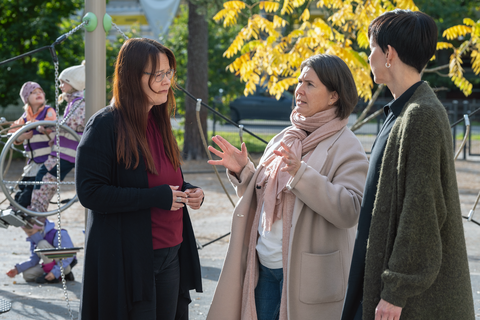Espoo invested in day care centre management – results in attractiveness and well-being at work

The assistant director model was introduced in Finnish early childhood education and care in Espoo in autumn 2023. The experiences of the management reform have been positive since the model was introduced a year ago.
One plus one is more than two, says Kati Smeds, District Manager in Early Education in Tapiola. Her statement is about the assistant director model of the City of Espoo.
‘Our organisations noticed that we needed more impactful and inspiring ways to manage early childhood education and care units,’ Smeds explains.
The management of day care centres was reformed with good results. Assistant directors support the management as they are hired to work in pairs with ECEC directors. By the end of 2024, 17 assistant directors will work in Espoo's Finnish-speaking day care centres, and more will be hired in 2025.
The goals are to streamline management, strengthen pedagogical management and share leadership.
The new Act on Early Childhood Education and Care, which entered into force in 2018, introduced new content requirements for early childhood education and care. Since then, the administrative work of directors has significantly increased as a wide range of obligations now has to be taken into account.
Experiences of co-management have been positive. So stated Katja Vuorento and Anne Koskinen, who work at Haukilahti and Toppelund day care centres. Vuorento is the director of the unit and Koskinen is the assistant director.
‘Management is challenging in such large entities. This was definitely a welcome change. It’s really important to have a reliable partner who shares the responsibility,’ says Vuorento.
Vuorento has felt that the model provides a lot of support for management. The assistant director does not have their own child group so they can focus on pedagogical management and share responsibility in other areas of management with the director of the unit. Koskinen has also found her tasks interesting and rewarding.
The City of Espoo’s investment in day care centre management is reflected in the attractiveness of the workplaces. The number of applicants in management recruitments has been increasing. Strengthening the well-being of managers and personnel has been an essential objective.
‘The entire work community benefits from better resources for the management,’ says Vuorento.
Similar experiments have been carried out elsewhere in Finland in different forms. In Finnish-language early childhood education and care in Espoo, the assistant director’s task is an independent management position. Work tasks are shared between the directors. It is also possible to brainstorm and develop operations with the partner.
‘One important thing from the point of view of the personnel is the increased presence of the director,’ Koskinen points out.
‘This is a great investment from the City of Espoo. It is great that the need has been seen, and that they have wanted to allocate funding for this,’ says Smeds.
Data on the assistant director model has only been gathered for one year, but the impacts on well-being at work have been positive. Kati Smeds emphasises that the development of well-being at work will be closely monitored.
Katja Vuorento says that many positive signs have emerged in personnel surveys. Employees feel that the director has time to lead and support the teams. The assistant director model allows spending more time on pedagogical management.
‘In the assistant director model, directors are better available, which strengthens the staff’s experience that they can get support for their work,’ says Vuorento.
High-quality early childhood education and care is an investment in the future. Its core is the well-being of personnel, Smeds emphasises.